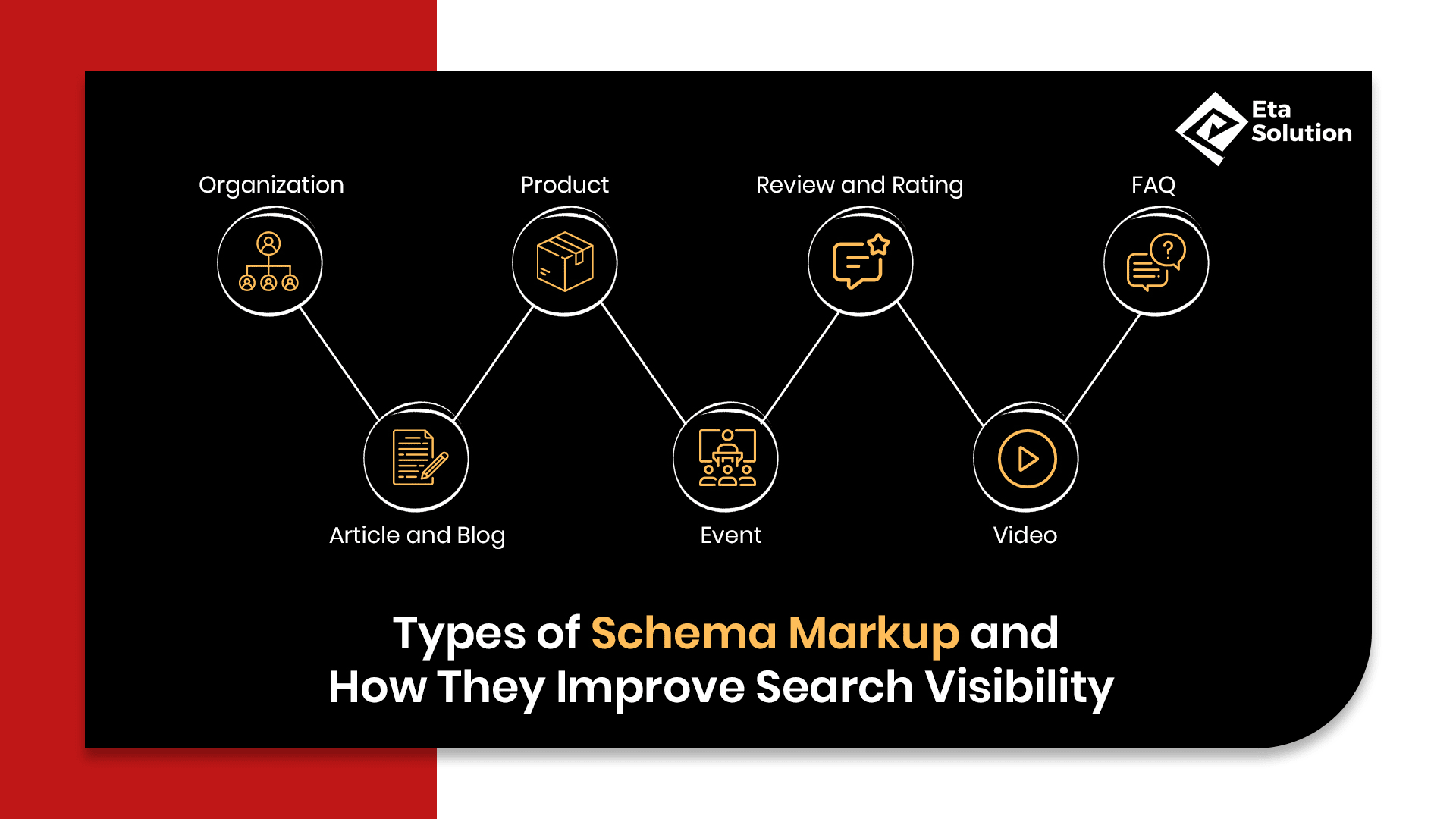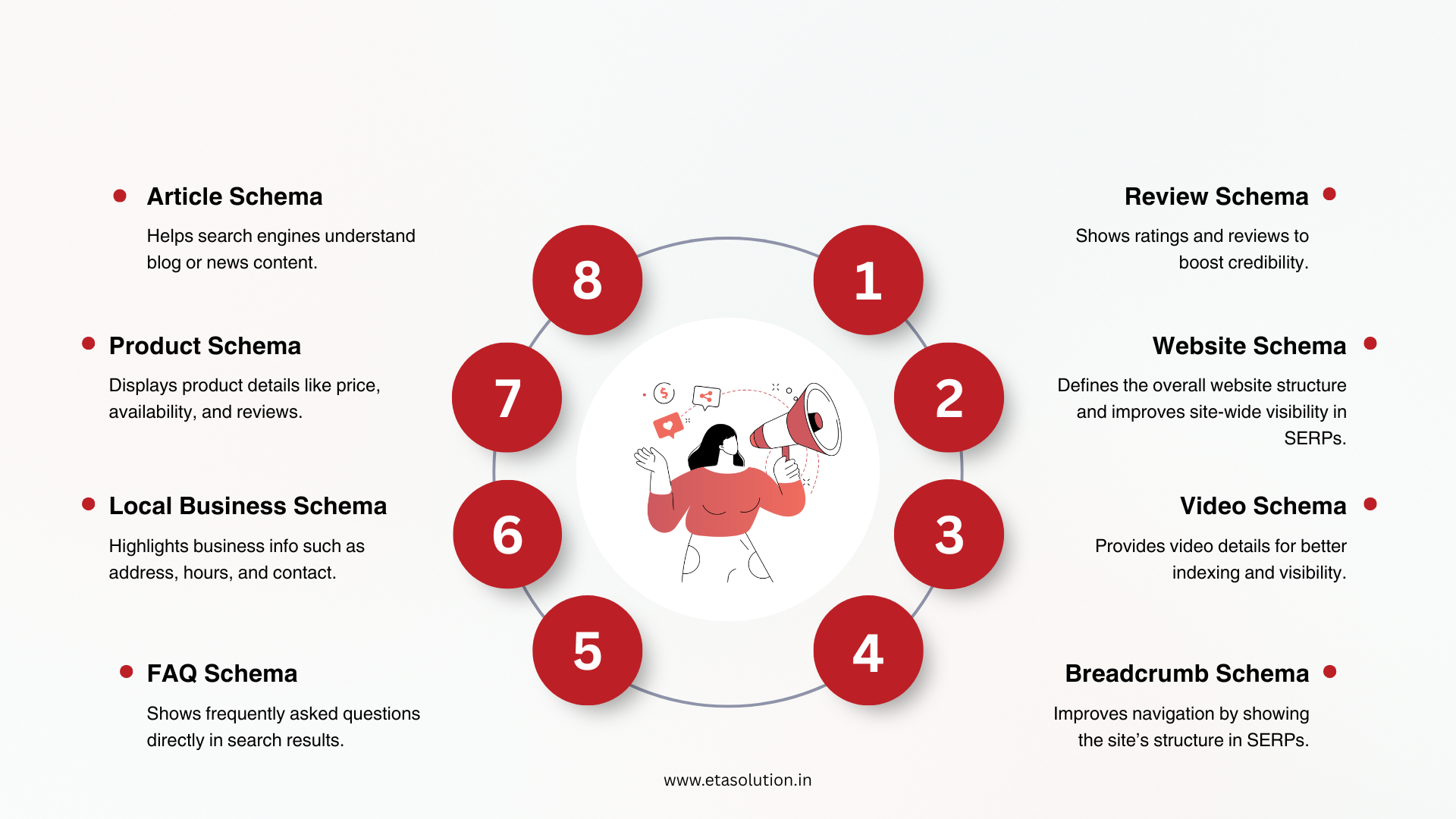
Types of Schema Markup & How They Boost Search Visibility | Complete Guide
If you’ve ever wondered why certain search results grab attention with star ratings, product prices, or FAQ drop-downs, the secret often lies in schema markup examples. Schema is full of potential to become an SEO hero that will help your site get noticed, even in the most competitive SERPs. Being the best digital marketing agency, we have observed the change in the presence of structured data, which especially happens when it is a very accurate implementation.
We would like to pull out the leading schema markup types, the reasons why they count, and how the organizations that have the upper hand in the market make use of them to dominate the search landscape.
Types of Schema Markup

Types of schema markup code formats are:
JSON-LD (JavaScript Object Notation for Linked Data)
Google’s recommended format.
Placed inside
<script type="application/ld+json">in the page<head>or<body>.Easier to implement and maintain without altering HTML structure.
Microdata
Uses HTML attributes (
itemtype,itemprop,itemscope) directly within the page content.Integrates schema markup inline with your HTML tags.
RDFa (Resource Description Framework in Attributes)
Similar to microdata but more complex.
Uses HTML5 attributes to add structured data in
<div>,<span>, etc.Can link data across different web pages.
Importance of SEO Schema Explained
Schema markup is a structured data vocabulary from schema.org that helps search engines comprehend your website content better. While traditional on-page SEO is heavily reliant on keywords and backlinks, machines using schema have a bit of a conversation with humans to get the context of the content.
- Without a schema, Google sees “Apple” as a word.
- With schema, Google understands whether you mean the fruit or the tech company.
According to a recent study by Milestone Research, websites using structured data saw a 30% higher CTR and a 25% increase in average ranking position compared to those without it. For decision-makers, this isn’t just technical fine-tuning; it’s a measurable growth lever.
How Schema Markup Enhances Search Visibility
Structured data SEO isn’t just about showing up; it’s about showing up with impact. Schema generates rich snippets of search results enhanced with visuals, ratings, FAQs, or video previews.
This has direct business implications:
- Improved engagement: Rich snippets attract attention and reduce bounce rates.
- Authority signalling: Enhanced results often reflect credibility.
- Voice search optimization: Schema is the foundation of how assistants like Alexa and Google answer queries.
Google itself has said that schema is not a direct ranking factor, but when it improves CTR and relevance, it indirectly boosts your rankings. This is How schema Improves Ranking without being an algorithmic lever.
Organization Schema: Boosting Brand Presence in SERPs
For businesses, organization schema is one of the most strategic moves. It tells search engines the official name, logo, contact info, and social profiles of your brand.
A practical example: Coca-Cola uses organization schema to ensure its brand assets are displayed consistently in search. The result? Enhanced brand awareness and lowered chances of being faked.
Such an issue is still more important for companies using local business schema SEO, because for them, it is necessary that there is consistency between their Google Business Profiles, websites, and structured data, as this is the way to get the highest trust signals.
Many companies collaborate with a top digital marketing agency in India to implement this correctly, ensuring global and local brand consistency across all digital touchpoints.
<script type="application/ld+json">{
"@context": "https://schema.org",
"@type": "Organization",
"name": "Example Organization",
"url": "https://www.example.com",
"logo": "https://www.example.com/logo.png",
"contactPoint": {
"@type": "ContactPoint",
"contactType": "Customer Support",
"areaServed": "Worldwide",
"availableLanguage": ["English"]
},
"sameAs": [
"https://www.facebook.com/example",
"https://www.twitter.com/example",
"https://www.linkedin.com/company/example"
]
}</script>
Product Schema: Driving Higher Click-Through Rates for E-Commerce
E-commerce platforms cannot afford to ignore product schema markup. When properly set up, it allows your products to display price, availability, and reviews right on the search page.
Take the example of Best Buy. Their product schema led to listings with availability tags (“In stock” or “Out of stock”), directly influencing buyer urgency. Studies show that rich product snippets can improve CTR by up to 35%.
This is why product schema isn’t just technical SEO; it’s a sales conversion strategy embedded directly into Google.
<script type="application/ld+json">{
"@context": "https://schema.org/",
"@type": "Product",
"name": "Example Product",
"image": [
"https://www.example.com/photos/product-image.jpg"
],
"description": "This is an example product description showcasing features and benefits.",
"sku": "EX12345",
"brand": {
"@type": "Brand",
"name": "Example Brand"
},
"offers": {
"@type": "Offer",
"url": "https://www.example.com/example-product",
"priceCurrency": "USD",
"price": "49.99",
"priceValidUntil": "2025-12-31",
"itemCondition": "https://schema.org/NewCondition",
"availability": "https://schema.org/InStock"
},
"aggregateRating": {
"@type": "AggregateRating",
"ratingValue": "4.5",
"reviewCount": "87"
},
"review": [
{
"@type": "Review",
"author": {
"@type": "Person",
"name": "John Doe"
},
"datePublished": "2025-09-18",
"reviewBody": "Great product, good quality and fast delivery.",
"name": "Excellent Product",
"reviewRating": {
"@type": "Rating",
"ratingValue": "5",
"bestRating": "5"
}
}
]
}</script>
Review and Rating Schema: Building Trust with Rich Snippets
Trust is currency in the digital. A schema for rich snippets displaying reviews and ratings can significantly influence clicks. Indeed, BrightLocal discovered that 87% of users believe online reviews to be as reliable as the advice of their friends or family.
One of the ways Amazon got this right is through displaying review numbers right in the search results, triggering the purchasing decision of potential customers even before they make a click to the site. For smaller businesses, review schema levels the playing field by giving credibility signals early in the user journey.
<script type="application/ld+json">{
"@context": "https://schema.org/",
"@type": "Product",
"name": "Example Product",
"aggregateRating": {
"@type": "AggregateRating",
"ratingValue": "4.4",
"reviewCount": "152"
},
"review": [
{
"@type": "Review",
"author": {
"@type": "Person",
"name": "Jane Doe"
},
"datePublished": "2025-09-18",
"reviewBody": "This product exceeded my expectations. Highly recommended!",
"name": "Great Quality Product",
"reviewRating": {
"@type": "Rating",
"ratingValue": "5",
"bestRating": "5",
"worstRating": "1"
}
}
]
}</script>
FAQ Schema: Increasing Visibility with Expandable Results
FAQ schema SEO allows websites to display question-answer drop-downs directly in SERPs. This feature is highly interactive and increases search real estate.
For example, HubSpot integrates FAQ schema into its blog content. The outcome? Users get quick answers, and HubSpot earns more impressions for long-tail queries. Interestingly, the FAQ schema also supports Voice search optimization, as assistants often read these answers directly.
<script type="application/ld+json">{
"@context": "https://schema.org",
"@type": "FAQPage",
"mainEntity": [
{
"@type": "Question",
"name": "What is schema markup?",
"acceptedAnswer": {
"@type": "Answer",
"text": "Schema markup is structured data code that helps search engines understand website content better and display rich results in SERPs."
}
},
{
"@type": "Question",
"name": "Why is schema markup important for SEO?",
"acceptedAnswer": {
"@type": "Answer",
"text": "Schema markup improves search visibility, increases click-through rates, and helps websites stand out with rich snippets in search results."
}
},
{
"@type": "Question",
"name": "Which format does Google recommend for schema markup?",
"acceptedAnswer": {
"@type": "Answer",
"text": "Google recommends using JSON-LD format for schema markup as it is easy to implement and does not interfere with the HTML structure of a webpage."
}
}
]
}</script>
Article and Blog Schema: Improving Content Discoverability
The article and blog schema are the main tools for publishers. It sends the title, author, date, and image information directly to search engines, thus facilitating content visibility in Google News and Discover.
One of the reasons why the NYT is at the top of the news is that it implements this schema very energetically. For brands running content marketing campaigns, adopting article schema is the missing link between great content and great discoverability.
<script type="application/ld+json">{
"@context": "https://schema.org",
"@type": "Article",
"headline": "Example Blog Post Title",
"description": "This is an example description of a blog post or news article.",
"image": "https://www.example.com/images/article-thumbnail.jpg",
"author": {
"@type": "Person",
"name": "John Doe"
},
"publisher": {
"@type": "Organization",
"name": "Example Publisher",
"logo": {
"@type": "ImageObject",
"url": "https://www.example.com/images/logo.png"
}
},
"datePublished": "2025-09-18",
"dateModified": "2025-09-18",
"mainEntityOfPage": {
"@type": "WebPage",
"@id": "https://www.example.com/example-article"
}
}</script>
Event Schema: Optimizing for Local and Global Events
If your business hosts webinars, conferences, or local meetups, event schema ensures these show up directly in search with dates, locations, and ticket links.
During the pandemic, Eventbrite saw a surge in online event attendance partly because the event schema allowed “Virtual” to appear as a tag in results. That simple visibility tweak meant higher registrations and smoother user discovery.
This is a classic case of structured data benefits going beyond SEO; it’s operational leverage.
<script type="application/ld+json">{
"@context": "https://schema.org",
"@type": "Event",
"name": "Example Conference 2025",
"description": "A sample event showcasing the use of structured data for SEO.",
"startDate": "2025-11-15T09:00",
"endDate": "2025-11-15T17:00",
"eventStatus": "https://schema.org/EventScheduled",
"eventAttendanceMode": "https://schema.org/OfflineEventAttendanceMode",
"location": {
"@type": "Place",
"name": "Example Convention Center",
"address": {
"@type": "PostalAddress",
"streetAddress": "123 Example Street",
"addressLocality": "New York",
"addressRegion": "NY",
"postalCode": "10001",
"addressCountry": "US"
}
},
"image": [
"https://www.example.com/photos/event.jpg"
],
"organizer": {
"@type": "Organization",
"name": "Example Organizer",
"url": "https://www.example.com"
},
"offers": {
"@type": "Offer",
"url": "https://www.example.com/event-tickets",
"price": "99.00",
"priceCurrency": "USD",
"availability": "https://schema.org/InStock",
"validFrom": "2025-09-18T12:00"
},
"performer": {
"@type": "Person",
"name": "Jane Doe"
}
}</script>
Video Schema: Enhancing Multimedia Search Results
Video is now central to SERPs. Video schema provides metadata like duration, description, and thumbnail, increasing the chance of your videos appearing in Google’s video carousel.
Consider how brands like TED use schema: their talks frequently show up in rich results with playable previews. This not only drives views but also strengthens brand positioning as an authority.
For businesses investing in content diversification, skipping video schema is leaving money on the table.
<script type="application/ld+json">{
"@context": "https://schema.org",
"@type": "VideoObject",
"name": "Example Video Title",
"description": "This is an example video description showing how to use schema markup for better search visibility.",
"thumbnailUrl": "https://www.example.com/thumbnail.jpg",
"uploadDate": "2025-09-18T08:00:00+00:00",
"duration": "PT2M30S",
"contentUrl": "https://www.example.com/videos/example-video.mp4",
"embedUrl": "https://www.example.com/videos/embed/example-video",
"publisher": {
"@type": "Organization",
"name": "Example Publisher",
"logo": {
"@type": "ImageObject",
"url": "https://www.example.com/logo.png",
"width": 200,
"height": 60
}
},
"interactionStatistic": {
"@type": "InteractionCounter",
"interactionType": { "@type": "WatchAction" },
"userInteractionCount": 1500
}
}</script>
Best Practices for Implementing Schema Markup Correctly
Implementing a schema requires precision. A few expert-backed practices:
- Stick to the official Schema org guide to avoid errors. Using non-standard attributes can cause Google to ignore your markup.
- Test before deployment with Google’s Rich Results Test. Even minor syntax issues can break schema visibility.
- Avoid spammy practices. Marking up irrelevant content (like fake reviews) can lead to manual penalties.
- Prioritize relevance. Focus on the types of schema in SEO most aligned with your goals, product, FAQ, or organization, rather than trying to implement everything.
The key is integration with your overall SEO strategy. Schema is not a one-off fix; it’s an evolving layer of structured context.
Final Take
Schema may not dominate headlines like AI or backlinks, but its compounding effect on visibility is undeniable. Brands that master schema are quietly gaining competitive advantages, whether it’s Best Buy boosting e-commerce CTRs or HubSpot using FAQ schema for long-tail reach.
The question is: will you let competitors take that search real estate first? For any business leader serious about long-term visibility, structured data is no longer optional. As a Top digital marketing agency in India, Schema is the missing bridge between content and discoverability. The sooner you adopt it, the more ground you’ll cover before the market catches up.
Not every website is required to have schema markup, but adding it is very helpful. It makes your site easier for search engines to understand and can make your results more attractive in Google with rich snippets.
Schema markup does not directly boost your rankings, but it helps your site stand out in search results. When people see rich snippets like ratings, FAQs, or events, they are more likely to click, which can indirectly improve your SEO performance.
Google recommends using JSON-LD format because it’s simple, clean, and easy to add to your website without messing up the existing HTML code.
Yes, schema markup gives clear and structured information that voice assistants like Google Assistant or Alexa can easily read. This increases your chances of being picked for voice search answers.
If schema markup is added with mistakes, Google may ignore it, show errors in Search Console, or not display rich results at all. That’s why it’s always a good idea to test your code using Google’s Rich Results Test tool.

What started as a passion for marketing years ago turned into a purposeful journey of helping businesses communicate in a way that truly connects. I’m Heta Dave, the Founder & CEO of Eta Marketing Solution! With a sharp focus on strategy and human-first marketing, I closely work with brands to help them stand out of the crowd and create something that lasts, not just in visibility, but in impact!

Industrial Product Marketing with LinkedIn & Paid Ads

Top Digital Marketing Strategies for Industrial Products in 2026

B2B Product Launch Strategies: From Pre-Launch to Go-To-Market

